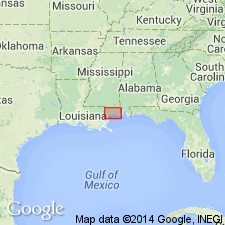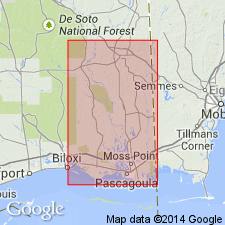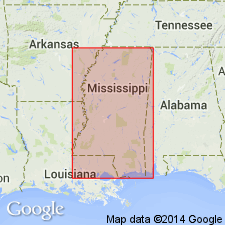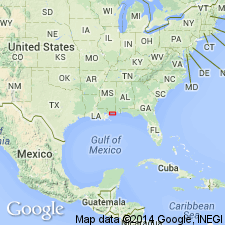
- Usage in publication:
-
- Graham Ferry formation*
- Modifications:
-
- Named
- Dominant lithology:
-
- Sand
- Clay
- AAPG geologic province:
-
- Mid-Gulf Coast basin
Summary:
Name Graham Ferry formation proposed for series of deltaic sediments overlying Pascagoula formation and disconformably underlying Citronelle Formation. Continental and brackish-water deposits predominate although type locality contains marine fossils. Thickness ranges from 113 ft in Jackson Co. to 975 ft at Gulfport. Age is Pliocene and Pleistocene.
Source: GNU records (USGS DDS-6; Reston GNULEX).

- Usage in publication:
-
- Graham Ferry Formation*
- Modifications:
-
- Age modified
- AAPG geologic province:
-
- Mid-Gulf Coast basin
Summary:
Age of Graham Ferry Formation changed from Pliocene and Pleistocene to Pliocene only. Formation contains the aquifer most widely used and most consistently present in vicinity of Pascagoula. Relation to underlying Pascagoula obscure and definite contact between formations in outcrop area has not been observed. Underlies Citronelle Formation.
Source: GNU records (USGS DDS-6; Reston GNULEX).

- Usage in publication:
-
- Graham Ferry
- Modifications:
-
- Not used
- AAPG geologic province:
-
- Mid-Gulf coast basin
Summary:
No stratigraphic reasons exist for the continued use of the term Graham Ferry Formation. Strata should be referred to as "Undifferentiated Neogene clastics" as they contain no time-diagnostic fossils and cannot be correlated with units that do. Term is still being used in the hydrogeologic literature, but boundary between the Graham Ferry and Pascagoula is arbitrary and is based on local aquifers. Pliocene lithosomes identified in southern AL and northwestern FL are here named the Perdido Key Formation, which bears no resemblance to the Graham Ferry of Brown and others (1944).
Source: GNU records (USGS DDS-6; Reston GNULEX).

- Usage in publication:
-
- Graham Ferry†
- Modifications:
-
- Abandoned
- AAPG geologic province:
-
- Mid-Gulf Coast basin
Summary:
"Units presently referred to as middle Miocene Hattiesburg, upper Miocene Pascagoula, and Pliocene Graham Ferry Formations do not have valid paleontological, lithologic or other stratigraphic support for their existence. They can not be satisfactorily delineated and correlated with units in other areas and it is suggested that these terms be discontinued and mapped as Neogene Undifferentiated nonmarine clastics."
Source: GNU records (USGS DDS-6; Reston GNULEX).

- Usage in publication:
-
- Graham Ferry Member
- Modifications:
-
- Revised
- AAPG geologic province:
-
- Mid-Gulf Coast basin
Summary:
Definition of Pensacola Formation is expanded to include strata between the early middle Miocene and the sub-Citronelle unconformities. The formation in the study area now encompasses the Amos Member, the Escambia Member, the Pascagoula Member, and the Graham Ferry Member, here reduced in rank. The Graham Ferry correlates with the Perdido Key Formation of FL and AL.
Source: GNU records (USGS DDS-6; Reston GNULEX).
- Usage in publication:
-
- Graham Ferry Member*
- Modifications:
-
- Revised
- Biostratigraphic dating
- AAPG geologic province:
-
- Mid-Gulf Coast basin
GNU Staff, 1995, Draft copy of Otvos, E.G., Mississippi Gulf Coast; geologic evolution, stratigraphy, coastal geomorphology, and Gulf-wide Pleistocene correlations, USGS Bull. XXXX (unpublished): U.S. Geological Survey Digital Data Series, DDS-6, 1 CD-ROM., release 3
Summary:
A maximum 4,900-ft-thick Miocene sequence underlies younger sandy-clayey alluvial-paralic deposits in MS. In absence of clearly definable and correlatable litho- or biostratigraphic horizons to bracket them, application of formation names, previously assigned to paralic-alluvial intervals (Oligocene to Miocene Catahoula Formation, Miocene Hattiesburg and Pascagoula Formations, and Pliocene Graham Ferry Formation; Brown and others, 1944) is unacceptable in MS. In intervals for which a Miocene or Pliocene age cannot be established, the term "undifferentiated Neogene clastics" is recommended. Whenever applicable, the names Pascagoula and Graham Ferry Members of Pensacola Formation are now used. Graham Ferry is Pliocene based on absence of RANGIA JOHNSONI, which indicates a post-Miocene age. PTEROCARYA pollens and IMPAGIDINIUM FENESTROSEPTATUM dinocysts confirm Pliocene age in uppermost part of sequence. Perdido Key Formation of Otvos (1988) of southern AL and westernmost FL, an apparent correlative to Graham Ferry, is nearest datable marine Pliocene unit in the coastal area. Author follows usage of Otvos (1994).
Source: GNU records (USGS DDS-6; Reston GNULEX).
For more information, please contact Nancy Stamm, Geologic Names Committee Secretary.
Asterisk (*) indicates published by U.S. Geological Survey authors.
"No current usage" (†) implies that a name has been abandoned or has fallen into disuse. Former usage and, if known, replacement name given in parentheses ( ).
Slash (/) indicates name conflicts with nomenclatural guidelines (CSN, 1933; ACSN, 1961, 1970; NACSN, 1983, 2005, 2021). May be explained within brackets ([ ]).

